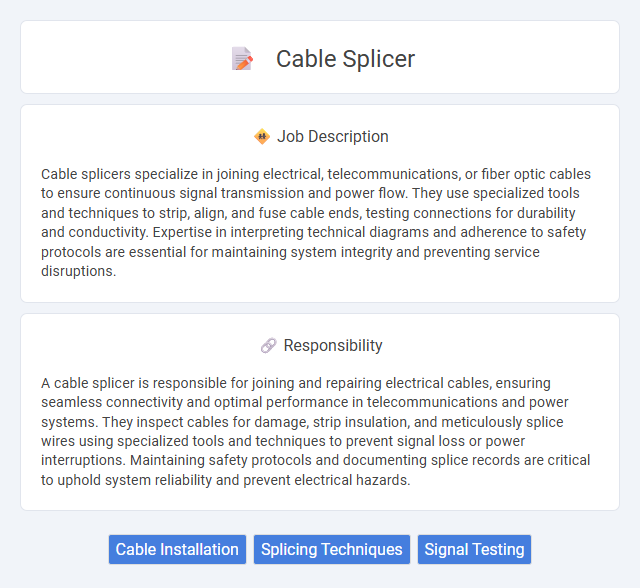
Cable splicers specialize in joining electrical, telecommunications, or fiber optic cables to ensure continuous signal transmission and power flow. They use specialized tools and techniques to strip, align, and fuse cable ends, testing connections for durability and conductivity. Expertise in interpreting technical diagrams and adherence to safety protocols are essential for maintaining system integrity and preventing service disruptions.
Cable splicer jobs often suit individuals with strong problem-solving skills and physical dexterity due to the intricate and hands-on nature of the work. Those who are comfortable working in varied weather conditions and at heights might find this role more fitting, while people with limited mobility or poor manual coordination could face challenges. The role probably demands good hand-eye coordination and an ability to concentrate for extended periods, making it less suitable for individuals who struggle with fine motor tasks or prolonged focus.
Qualification
Cable splicers must possess specialized training in fiber optic and electrical cable systems, often requiring certifications such as OSHA safety standards and NCCER credentials. Proficiency in reading technical blueprints, using precision tools, and conducting rigorous testing ensures high-quality cable joints. Strong problem-solving skills and physical stamina are essential for working in varied environments, including underground and aerial installations.
Responsibility
A cable splicer is responsible for joining and repairing electrical cables, ensuring seamless connectivity and optimal performance in telecommunications and power systems. They inspect cables for damage, strip insulation, and meticulously splice wires using specialized tools and techniques to prevent signal loss or power interruptions. Maintaining safety protocols and documenting splice records are critical to uphold system reliability and prevent electrical hazards.
Benefit
Cable splicer jobs likely offer competitive wages and job stability due to the essential nature of maintaining communication and electrical networks. Workers in this field probably benefit from opportunities for hands-on skill development and specialized certifications, which can enhance career advancement. The role may also provide a sense of contribution to critical infrastructure, leading to job satisfaction in ensuring uninterrupted services.
Challenge
Working as a cable splicer likely involves considerable challenges due to the complexity of joining electrical and communication cables in various environments. The probability of encountering hazardous conditions and working in confined spaces is high, requiring precise skills and safety awareness. Adapting to intricate wiring systems and troubleshooting faults may frequently test problem-solving abilities.
Career Advancement
Cable splicers gain valuable hands-on experience working with fiber optic and copper cables, which serves as a foundation for advancing to roles such as network technician, telecommunications engineer, or project manager. Certification programs in fiber optic splicing and knowledge of industry standards like TIA/EIA can enhance career prospects and open opportunities in higher-paying positions. Continuous skill development in fiber optics technology, troubleshooting, and safety protocols is critical for progression within telecommunications and utility sectors.
Key Terms
Cable Installation
Cable splicers specialize in joining and repairing electrical or fiber optic cables to ensure seamless connectivity and optimal signal transmission. Their expertise in cable installation involves preparing cables, stripping insulation, aligning fibers or wires with precision, and using heat or mechanical processes to create secure, durable splices. Proficiency in reading technical blueprints, handling specialized tools, and adhering to safety standards is essential for effective cable installation and maintenance.
Splicing Techniques
Cable splicer jobs require expertise in various splicing techniques such as mechanical splicing, fusion splicing, and thermal splicing to ensure optimal signal transmission and minimal signal loss. Proficiency in using specialized tools like fusion splicers and cleavers is crucial for creating precise, durable joints in fiber optic or electrical cables. Mastery of these techniques enhances network reliability and reduces downtime in telecommunications and power distribution systems.
Signal Testing
Cable splicers perform critical signal testing to ensure optimal connectivity and transmission quality in fiber optic and copper cables. Using specialized equipment like OTDR (Optical Time-Domain Reflectometer) and multimeters, they identify faults, measure signal loss, and verify splice integrity. Accurate signal testing minimizes network downtime and enhances communication reliability in telecommunications infrastructure.
 kuljobs.com
kuljobs.com